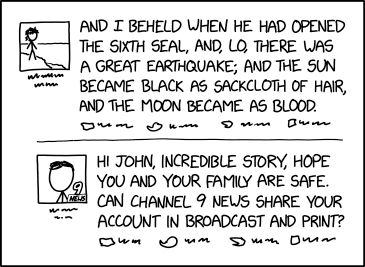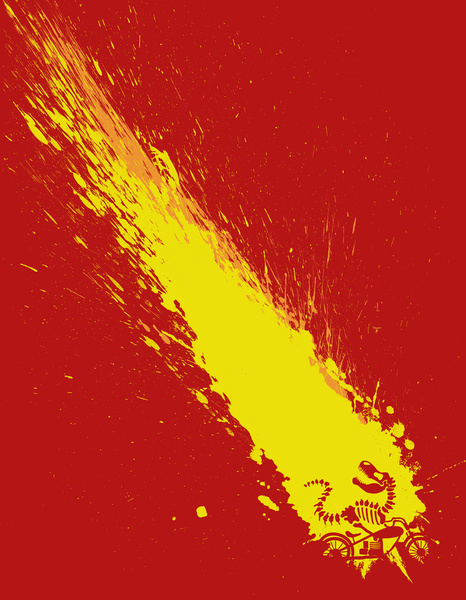 (Illustration: Tall El Hammam in perspective; image found here).
(Illustration: Tall El Hammam in perspective; image found here).
Off the regular news cycle on a mid-day Tuesday with a shout-out to a historical study on the destruction of an ancient city supposedly caused by a ‘cosmic airburst,’ maybe the city of Sodom — yesterday I came across a report published at Nature on the research results, and although the data presented can’t claim 100-percent the now-ruins is/was the Biblical city, apparently, the place does ring the artifact-bells of confirmation.
From the study’s Abstract:
We present evidence that in 1650 BCE (3600 years ago), a cosmic airburst destroyed Tall el-Hammam, a Middle-Bronze-Age city in the southern Jordan Valley northeast of the Dead Sea.
The proposed airburst was larger than the 1908 explosion over Tunguska, Russia, where a 50-m-wide bolide detonated with 1000×more energy than the Hiroshima atomic bomb.
…
Tall el-Hammam may be the second oldest city/town destroyed by a cosmic airburst/impact, after Abu Hureyra, Syria, and possibly the earliest site with an oral tradition that was written down (Genesis).
Tunguska-scale airbursts can devastate entire cities/regions and thus, pose a severe modern-day hazard.
And that ‘Tunguska-scale’ event is sone deep-fright shit — from EarthSky this past June:
The blast released enough energy to kill reindeer and flatten an estimated 80 million trees over an area of 830 square miles (2,150 square km). Witnesses reported seeing a fireball — a bluish light, nearly as bright as the sun — moving across the sky.
A flash and a sound similar to artillery fire was said to follow it. A powerful shockwave broke windows hundreds of miles away and knocked people off their feet.A mysterious aspect of the Tunguska event was that no crater was ever found. But, even without a crater, scientists still categorized it as an impact event.
They now believe the incoming object never struck Earth, but instead exploded in the atmosphere, causing what’s known as an air burst.
This type of atmospheric explosion was still enough to cause massive damage to the forest in the region.
Yet decades passed before anyone could explain the event.
Meanwhile, investigations/digging-searches recorded in the research published at Nature revealed no pieces/fragments of war materials like arrowheads, swords, spear points, military whatnot, in the rubble zone, thus, discounting Tall el-Hammam being destroyed by battle/siege/conflict — in fact, evidence points to a quick kill:
In addition to the usual debris patterns typical of ancient cities destroyed by warfare and earthquakes, the excavations of the final phase of the MB II stratum revealed highly unusual materials: pottery sherds with outer surfaces melted into glass, some bubbled as if ‘boiled;’ melted and ‘bubbled’ mudbrick fragments; partially-melted roofing clay (with wattle impressions); and melted building plaster.
These suggest that the city’s destruction was associated with some unknown high-temperature event.
And the question of Sodom:
There is an ongoing debate as to whether Tall el-Hammam could be the biblical city of Sodom (…), but this issue is beyond the scope of this investigation. Questions about the potential existence, age, and location of Sodom are not directly related to the fundamental question addressed in this investigation as to what processes produced high-temperature materials at Tall el-Hammam during the MBA.
Nevertheless, we consider whether oral traditions about the destruction of this urban city by a cosmic object might be the source of the written version of Sodom in Genesis.
We also consider whether the details recounted in Genesis are a reasonable match for the known details of a cosmic impact event.
If you way-into scientific materials, go read the whole piece, and it’s long — I read a great deal, but gave up on the deep-dive work shown on the scrolls. A way-shitload more information than my non-science/math brain can handle.
Additional news stories here and here, with a really-good, in-depth review of the study (and history) at The Conversation yesterday, which concluded:
Tunguska-sized airbursts, such as the one that occurred at Tall el-Hammam, can devastate entire cities and regions, and they pose a severe modern-day hazard.
As of September 2021, there are more than 26,000 known near-Earth asteroids and a hundred short-period near-Earth comets. One will inevitably crash into the Earth. Millions more remain undetected, and some may be headed toward the Earth now.Unless orbiting or ground-based telescopes detect these rogue objects, the world may have no warning, just like the people of Tall el-Hammam.
Something to ponder.
And ending in context — earlier this morning I spied a next-of-kin reflection-snap at Miss Cellania:

And once again, more-than historically speaking, here we are again…
 (Illustration out front: ‘Meteor,’ found here).
(Illustration out front: ‘Meteor,’ found here).